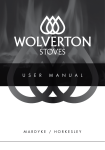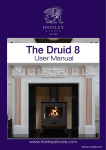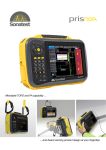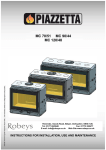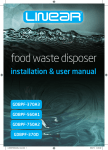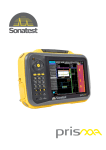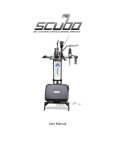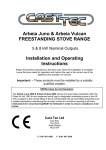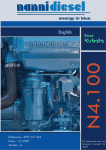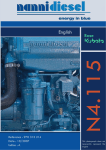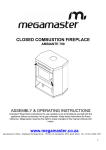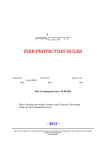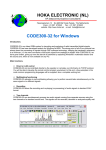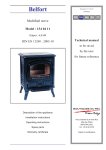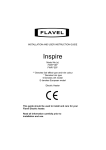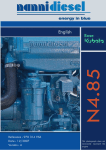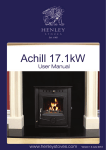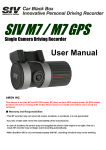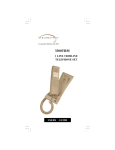Download User Manual 9KW Stove
Transcript
WOLVERTON STOVES U S ER M AN U AL B l a r n e y / EL S E C AR C O N T EN T S This User Manual applies to Blarney & Elsecar stoves SECTION ONE: I. Technical Data..............................................................................................................4 II. Technical Description......................................................................................................4 SECTION TWO: INSTALLATION INSTRUCTIONS I. Health and Safety..........................................................................................................5 II. Stove Installation............................................................................................................5 III. Chimney......................................................................................................................6 IV. Flue Connection............................................................................................................6 V. Hearth and Fire Surround................................................................................................8 VI. Ventilation....................................................................................................................8 SECTION THREE: OPERATING INSTRUCTIONS I. Stove Model...............................................................................................................10 II. Fume Emissions...........................................................................................................11 III. Use in a Boat or Mobile Home......................................................................................11 IV. Use of a Fire Guard.....................................................................................................11 V. Use of a Spark Guard..................................................................................................11 VI. General Use...............................................................................................................11 VII. Fuel..........................................................................................................................12 VIII. Initial Burning and Curing..............................................................................................12 IX. Lighting a Log Fire.......................................................................................................12 X. Overnight Burning.......................................................................................................13 XI. Air Controls................................................................................................................13 XII. Ash Clearance and Disposal.........................................................................................13 XIII. Flue Draughts..............................................................................................................14 XIV. Maintenance..............................................................................................................14 GENERAL SAFETY INFORMATION † This appliance must be installed and commissioned by a fully qualified, registered installer. HETAS registered installers are recommended by Wolverton Stoves. Please visit www.hetas.co.uk for a list of approved installers in your area. • This appliance must be installed as per these instructions. No modifications or alterations of any kind are permitted and will invalidate the warranty. All relevant regulations must be complied with and installation should be in accordance with the latest version of Building Regulations Document J in England and Wales, Document L in Northern Ireland and Part F of the Building Regulations in Scotland. • With correct installation, operation and maintenance this appliance will not emit fumes into the dwelling. However, occasional fumes may be emitted when refuelling or removing ash. • An adequate air supply for combustion and ventilation is required. If the stove you have purchased exceeds 5.0kW nominal heat output, a purpose provided air vent is always required. • If your stove has a lower nominal heat output than 5.0kW, a purpose provided air vent is not usually required. However, one may need to be fitted in small or tightly sealed rooms. Air openings provided for this purpose must not be restricted. See Building Regulations Document J (Document L in Northern Ireland) for further information and seek expert advice if in any doubt. • Always ensure your stove is maintained and kept in good mechanical order. This will ensure safety and maximise efficiency. • Flueways must be cleaned frequently and chimneys must be swept regularly. The chimney should be swept at least once a year for smokeless fuel. If using other fuels, this should be carried out twice per † year. Please contact your local, HETAS registered chimney sweep for advice. WARNING: If the chimney is thoroughly and regularly swept, chimney fires should not occur. If a chimney fire does occur, turn off the stove immediately and tightly close the doors of the stove. This should cause the chimney fire to go out. If it does not go out as a result of the above action, the fire brigade should be called immediately. Do not relight the stove until the chimney and flueways have been cleaned and examined by a professional. 2|3 † or equivalent local body SECTION ONE: I. TECHNICAL DATA TOTAL OUTPUT: (KW) 9.0 PRODUCT EFFICIENCY (%) 93 MINIMUM FLUE PIPE DIAMETER: (mm) 125 MAXIMUM QUANTITY OF FUEL - WOOD: (KG) 0.2 WOOD CONSUMPTION PER HOUR (WOOD WITH MAX 20% HUMIDITY): (KG) 1.1 TOTAL WEIGHT OF THE APPLIANCE: (KG) 110 WIDTH: (mm) 490 DEPTH: (mm) 425 HEIGHT: (mm) 620 REMOVABLE ASH PAN YES II. TECHNICAL DESCRIPTION This stove is suitable for heating living spaces in most homes. The appliance has been developed to burn wood as its primary fuel source. This stove is made primarily from cast iron with plates of sheet steel. The fire chamber is internally lined with cast iron firebricks. There is a riddling grate for clearing ash. The stove is equipped with ceramic glass (resistant up to 800ºC) this provides an exceptional view of the combustion, whilst also preventing sparks and smoke deposits from escaping. The appliance is equipped with primary and secondary air controls, by which it is possible to control the burn rate and therefore the output of the appliance. SECTION TWO: INSTALLATION INSTRUCTIONS Please read this guide carefully prior to installation and retain for reference purposes. I. HEALTH AND SAFETY All installation work must meet with the requirements of the Health and Safety at Work Act 1974. Appropriate protective equipment must be worn to ensure the safety of persons carrying out the installation. Attention must be given to the possibility of disturbing asbestos. This should only be removed by a licensed contractor. Contact the Health and Safety Executive to ensure your contractor passes the essential requirements for removal and disposal. Fire cement is caustic - hand and eye protection should be worn when handling, chiselling or looking up the chimney. Avoid prolonged contact with the skin. If contact occurs, wash skin immediately. The appliance is heavy and care must be taken during handling. Do not attempt to move the stove alone. Use a handcart to position the appliance. Never drag the stove as this may cause damage. WARNING: Parts of the appliance, especially external surfaces, will be extremely hot during operation. Due care must be taken to prevent injury. WARNING: Only recommended fuels must be used in this appliance, please see Section Three for details of recommended fuel. II. STOVE INSTALLATION IMPORTANT: Any manufacturer’s instructions must not be taken as overriding statutory requirements. † Please consult a local Building Control Officer or HETAS registered installer for further advice on all information contained below. The installation of this stove must comply with the following requirements: 1) BS 8303: Code of Practice for the installation of domestic heating and cooking appliances burning solid mineral fuel. 2) BS 6461: Installation of chimneys and flues for domestic appliances burning solid fuel (including wood and peat). Code of practice for masonry chimneys and flue pipes. 3) Building Regulations regarding the installation of solid fuel burning appliances, flues and chimneys. 4) Local Authority Byelaws. 4|5 † or equivalent local body The installation of this stove is a notifiable building works as defined in the building regulations. It is a legal requirement under England and Wales Building Regulations that the installation is either carried out under Local Authority Building Control approval or is installed by a Competent Person † registered with a Government approved Competent Persons Scheme. HETAS Ltd operates such a Scheme and a listing of its Registered Competent Persons can be found on its website at www.hetas.co.uk. III. CHIMNEY The chimney height must be no less than 4.5 metres (14’ 9”), measured vertically from the top of the stove to the top of the chimney. It should terminate in accordance with the latest version of the Building Regulations. Optimum internal dimensions of the chimney should be 175mm (7”) or 200mm (8”) either square or round, and must not be less than 150mm (6”) diameter. This appliance must be installed into a ‘Class 1 Chimney’ (insulated metal). Installation with an older chimney is a potential fire hazard. Prior to installation, existing chimneys must be swept and examined by a competent person to ensure safety and suitability. The chimney must be in good condition with no cracks or blockages. If the chimney is in poor condition or covers an excessive cross-sectional area, seek expert advice from † a qualified, HETAS approved chimney engineer. It may be necessary to have the chimney lined with a solid fuel compatible liner. Where the chimney is believed to have previously served an open fire installation, it is possible that the higher flue gas temperature from a closed appliance may loosen deposits that were previously firmly adhered. This can result in flue blockage. In this instance, the chimney must be swept a second time within a month of regular use after installation. If there is no existing chimney, a prefabricated block chimney or a twin walled, stainless steel flue to EN 1856-2 can be used either internally or externally. This must be fitted in accordance with the † manufacturer’s instructions and Building Regulations. It must also be tested to HETAS requirements. Seek † expert advice from a qualified, HETAS registered chimney engineer. † or equivalent local body IV.FLUE CONNECTION WARNING: The flue pipe diameter must not be less than the recommended diameter for the outlet of the appliance, stated below. Avoid using bends greater than 45 degrees to the vertical. WARNING: All joints in the flue system must be effectively sealed. Check the appliance for soundness of seals between castings and main components prior to use. The stove must be connected to the chimney using 125mm (5”) diameter flue pipe and is supplied ready for top or rear flue connection. It is recommended that this connects to 150mm (6”) flue pipe as soon as possible to prevent blockages occurring. This must travel at least 600mm vertically before any change of direction. It is important that connector pipe is made from 24-gauge steel or cast iron and is more than 455mm (18”) away from any combustible wall or ceiling. Please follow the manufacturer’s instructions for passing through walls and ceilings. The stove is designed to connect to a flue system such as masonry or pre-manufactured lined pipe system that meets Building Regulations. If you intend to use existing masonry chimney it is important to check for cracks in the liner. If the masonry flue is not to specification the flue should be lined with a Class 1 stainless steel liner. Any existing stainless steel liner should be carefully checked for buckling, warping or cracks prior to † installing your stove. It is also necessary to clean your liner and chimney using a qualified, HETAS approved chimney sweep. Check the flue is functioning correctly and ensure all products of combustion are vented to the atmosphere through the chimney terminal. Do not use single wall chimney connector pipe as a chimney on any stove. Connect your stove to an approved flue system serving only one appliance. All pipe joints and the connection to the heater collar must be firmly secured. External flues must be insulated to prevent heat loss. 6|7 † or equivalent local body V. HEARTH AND FIRE SURROUND In conformity with Building Regulations, the stove should be installed on a solid, non-combustible surface such as concrete or masonry. This must be at least 125mm (5”) thick. The specified depth may include the thickness of any solid non-combustible floor beneath the hearth. Combustible material should not be placed beneath constructional hearths unless there is an air-space of at least 50mm between the underside of the hearth and the combustible material, or the combustible material is at least 250mm (10”) below the top of the hearth. Dimensions of the hearth should project at least 300mm (12”) forward of the front of the appliance and 150mm (6”) at the sides. The stove must be situated at least 1000mm (40”) from any combustible material including furniture, magazine rack and clothing etc. Do not dry clothes on or within this proximity of the stove. Fire recesses must be constructed from non-combustible material. The minimum clearance between the stove and the recess wall should be 76mm (3”). IMPORTANT: Do not install the stove in closets or alcoves. Central locations are desirable; however the minimum run of pipe to the chimney should be the deciding factor when choosing a location. Do not store flammable liquids in the same room as the stove. Minimum wall clearance must be maintained as illustrated below. BACK WALL A SIDE WALL B ADJACENT WALL SIDE WALL A SIDE WALL SIDE WALL B BACK WALL ADJACENT WALL C C C SIDE WALL A - 229 mm / 9” SIDE WALL A - 229 mm / 9” BACK WALL B - 76 mm / 3” CORNER C -B 26-mm 1” BACK WALL 76/ mm / 3” CORNER C - 26 mm / 1” C VI. VENTILATION If your stove has a lower nominal heat output than 5.0kW, a purpose provided air vent is not usually required. However, one may need to be fitted in small or tightly sealed rooms to ensure the efficient combustion of air. Air openings provided for this purpose must not be restricted. See Building Regulations Document J (Document L in Northern Ireland) for further information and seek expert advice if in any doubt. For every kW above 5.0kW, a permanent vent with a total free area of at least 550mm (22”) should be connected directly to the outside air. Failing this, it should be connected to an adjacent room which itself has a permanent vent of the same size direct to the outside air. An extractor fan must NOT be fitted in the same room as the stove. This can prevent the chimney from drawing correctly, resulting in the emission of fumes into the room. Installation of an extractor fan in an adjacent room may also prevent the chimney from functioning correctly and is not advised. IMPORTANT: On completion of the installation and commissioning, please leave the Installation and User Instructions and leave the User Manual and any operating tools supplied. Explain the correct operation and maintenance of the appliance to the user. 8|9 SECTION THREE: OPERATING INSTRUCTIONS Prior to using your stove for the first time, it is essential that all requirements detailed in Section Two have been met. With correct installation, operation and maintenance this appliance will not emit fumes into the dwelling. At least once a year before putting your stove into service your chimney flue should be cleaned of soot † and residue. Consult a HETAS registered chimney sweep regarding regular cleaning and maintenance. IMPORTANT NOTES: • The appliance must not be left unattended during the initial lighting sequence. • Do not overload the appliance with fuel. • Do not attempt to open the door immediately after igniting the fire. • Do not burn wood containing chemicals such as glue or paint. • Do not attempt to burn any liquid fuel in the stove. • Never use aerosol spray near the stove when it is alight. • If the appliance is left running with the air controls open for extended periods, serious damage can occur. I. Flue Outlet Air Wash / Top Vent Glass Door Handle Main Vent † or equivalent local body II. FUME EMISSIONS Occasional fumes from ash clearance and refuelling may occur. However, persistent fume emission is potentially dangerous and must not be tolerated. If fume emission persists, the following immediate actions should be taken: a) b) c) d) Open doors and windows to ventilate room. Put the fire out or eject and safely dispose of fuel from the appliance. Check for flue or chimney blockage. Clean if required. Do not attempt to relight the fire until the cause of the fume emission has been identified and corrected. If in doubt, seek expert advice. The most common cause of fume emission is flue way or chimney blockage. For your safety, these must be kept clean at all times. Any permanent air vent provided for combustion must not be blocked off. WARNING: There must not be an extractor fan fitted in the same room as the stove. This can cause the emission of dangerous fumes into the room. III.USE IN A BOAT OR MOBILE HOME Stoves can be used in these environments, however installation and use requires common sense and care. It is particularly important to be aware of the proximity of the stove to combustible materials. This poses a potential fire risk. Please seek expert advice prior to installation and use. Particular care must also be taken when refuelling and removing ash from the stove. The appliance may be used with the doors open however a spark guard conforming to BS 6539 should always be used. In such installations, it is not safe to leave the stove unattended with the doors open. IV.USE OF A FIREGUARD In the presence of children, adults and/or infirm persons, a fireguard must be used. This should be manufactured in accordance with BS 6539. V. USE OF A SPARK GUARD A spark guard conforming to BS 6539 should always be used when the stove is left burning with the door(s) open. VI.GENERAL USE For maximum efficiency, the stove should be run with the door(s) closed. The stove should only be run with the doors open to give a temporary boost to the radiant heat output. WARNING: Running a stove with the door(s) open for long periods can increase the risk of a chimney fire. 10|11 VII.FUEL Only premium coal, approved smokeless fuel or wood must be used with this stove. It is best to use dry, well seasoned wood such as oak, ash or beech. A moisture content of between 12% and 20% by weight is acceptable. Seek further advice from your local fuel merchant. VIII.INITIAL BURNING AND CURING Prior to use, this appliance must be installed and commissioned by a fully qualified, registered † installer. HETAS registered installers are recommended by Wolverton Stoves. Please visit www.hetas. co.uk for a list of approved installers in your area. WARNING: Never touch the stove with your bare hands when it is hot. When the stove is in use, all surfaces of the stove will reach high temperatures. Always use appropriate tools and heat-proof gloves to minimise the risk of injury. If burning wood, remove the multi-fuel grate. Instead, burn on 25mm (1”) thicker layer of sand to prevent the wood burning too quickly. If burning coal, leave the multi-fuel grate in place. For the first week, light small fires to prevent the cast expanding too quickly. During this time you may gradually increase the burning period. Initially, the stove may smoke and give off an odour as the silicon paint in the firebox reacts to the heat. This is normal and will cease after a short time. In the meantime, the room should be kept well ventilated and not be used until the vapour disperses. This should not be confused with fume emission. Avoid running the stove at full capacity for a few days, enabling the paint to cure fully. IX.LIGHTING A LOG FIRE • Ensure the stove firebox is not full of ash. Remove ash if necessary. • Use scrunched up balls of newspaper and dry kindling to start the fire. Place these in the centre of the firebox. • Ensure all air vents are open. • Light the newspaper and close the door. Allow a few minutes for the fire to establish itself. • When the fire is burning hot, add small pieces of hardwood. Keep all air vents fully open until a bed of hot, glowing timbers is established. • Open the door and rake the embers evenly. Add larger pieces of wood to the firebox, approximately 3-4 at a time. • Reduce the air supply gradually until desired fire is achieved. † or equivalent local body X. OVERNIGHT BURNING When leaving the stove in use overnight, the fire door must be closed. Close all air flow dials and dampen the fire down by covering it with a coating of coal dust or dross. IMPORTANT • Do not fully load the appliance until you are familiar with the operation of all stove controls. • Do not open the loading door too quickly when reloading the appliance. This can cause flames to flash out of the stove similarly to a ‘mini-explosion’. • Do not burn painted or varnished woods, MDF, oak barn or wood with more than 20% humidity. XI.AIR CONTROLS It is essential that the fire has an adequate air supply for combustion and ventilation. The apertures provided for this purpose must not be restricted. Leaving the vents fully open for long periods, however, can cause over-firing. For overnight burning, the air vents should be closed. The airwash vent is located at the top of the stove door. This controls the burning rate and keeps the glass clean. When fully open, this gives full airwash for faster burning and clean glass. Fully closed gives slow, overnight burning. A fully closed airwash control will not keep the glass clean, especially immediately after refuelling. XII. ASH CLEARANCE AND DISPOSAL The appliance must have ash removed from the ashpan on a regular basis. Ash should be removed from the fire chamber and ashpan using a suitable tool such as a brush or ash vacuum. Never allow ash to accumulate so that it comes into contact with the underside of the grate as this can cause damage. It is important that all air vents are clear of ash and there is no ash build up on baffles or firebricks. This needs to be done as and when necessary to maintain free movement of air inside the stove. The efficient operation of your stove is dependant on correct operation and maintenance. Failure to carry out the removal of ash will significantly reduce output. Ensure ash is cool before emptying into plastic liners or dustbins. CAUTION: Each stove has a kilowatt rating. This is the approximate maximum temperature the casting is able to cope with. It does not relate to heat production which depends on the type and quantity of fuel used. If you require less heat, burn a smaller fire. If the stove becomes white or red hot, spray the fire down with water from a plant spray. 12|13 XIII.FLUE DRAUGHTS Draught is created by warm air exiting the stove and rising in the collar air of the chimney. Prior to installation, the chimney can be checked with a smoke pellet. If the chimney does not pull the † smoke, it may need attention. Seek advice from a qualified, HETAS registered chimney engineer. It is very important to maintain an adequate draught at all times. The following factors can affect the draught. 1. An air leak in the stove or chimney. 2. Faulty stove or door gaskets, or doors not closed tightly. 3. The stove pipe, outlet or chimney is blocked. 4. The chimney temperature. 5. Obstructions such as trees or buildings close to the top of the chimney. 6. The chimney flue is too large. 7. Vented exhaust fans (such as in a kitchen) are causing low draught and pulling air downwards. CAUTION: Some of these situations can cause down draught which is dangerous. Seek expert advice. † If you have doubts about any of these issues, do not use the stove and contact a HETAS registered installer immediately. XIV.MAINTENANCE It is essential to regularly maintain your stove and clean you chimney. Failure to do so can cause poisonous gases to enter your home. The stove should only be cleaned when it is cold. DAILY CARE: A daily wipe-over with a lint-free cloth, hot water and soap is sufficient to clean the stove on a daily basis. The door glass can be cleaned with glass cleaning liquids purchased from stove shops, and a dry cloth. REGULAR CARE: The stove should be inspected for fly ash build up bi-monthly during the heating season. Pay attention to the elbows in the stove pipe as this is where ash tends to accumulate. CHIMNEY CLEANING: It is important that your installer provides access to the chimney and connecting flue pipe for cleaning. The design of some models does not allow sweeping through the stove. Cleaning doors must always be accessible. † or equivalent local body 6 WOLVERTON STOVES All stoves feature a comprehensive 1 year parts (glass excluded) and labour guarantee.* This does not affect your statutory rights. Exclusively distributed in the UK & Ireland by GM Distribution. 70 High Park Drive, Old Wolverton Mill, Milton Keynes MK12 5TT [email protected] Specifications correct at time of going to press, we operate a policy of continuous improvement and reserve the right to amend product specifications without notice. Please consult your dealer prior to purchase. All references to GB Building Regulations are correct at time of going to press. Please reconfirm with your installer prior to installation as regulations may change. If being installed outside GB, please refer to local building regulation. *Labour must be ‘reasonable’ as defined by the manufacturer. Reasonability must be confirmed by the manufacturer prior to any remedial work being carried out. E & OE November 2010
















